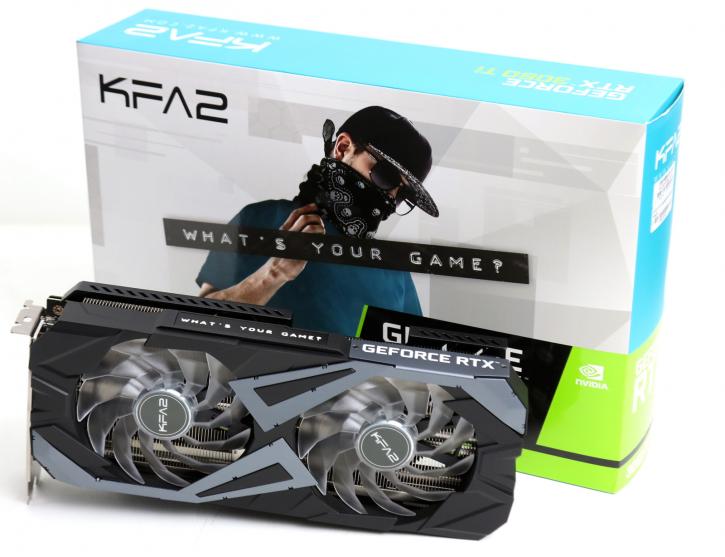Introduction
KFA2 GeForce RTX 3060 Ti EX
WHAT'S YOUR GAME? We review the KFA2 GeForce RTX 3060 Ti EX 8GB; it's the value proposition from the company behind KFA2, GALAX. Armed with a duo of spinners and aimed at GeForce RTX 2080 SUPER performance levels, this product will be matching the founder edition pricing. That makes this a proposition from GALAX/KFA2. Armed with a shader core count of 4864 units, this card is paired with 8 GB of GDDR6 graphics memory running 14 Gbps. Much has been said, rumored, and spoken about this card, as with that sexy shading core count, it is bound to be a bit of a beast in that sub-400 EUR/USD price range. This product will sit at GeForce RTX 2080 (SUPER) performance levels and, in due time, will be its replacement. September 2020, NVIDIA declared its initial Ampere graphics cards in its inaugural launch wave. A week before announcements, specifications of the GeForce RTX 3060 Ti, 3070, 3080, and 3090 took a twist; the shader core count mysteriously doubled from what everybody expected. The GPUs are fabricated on an 8nm node derived from Samsung. This process further develops Samsung's 10nm process; no EUV is applied in production just yet. The first wave of announcements would see the GeForce RTX 3080 and 3090 being released first, and, as a bit of a surprise, the GeForce RTX 3060 Ti and 3070 would be arriving in roughly the same timeframe as well.
Ampere for consumers now entails the GeForce RTX 3060 Ti 8GB, 3070 8GB GDDR6, RTX 3080 10GB GDDR6X, the 24GB GDDR6X based premium flagship, the mighty mo, the GeForce RTX 3090. The lineup nearly doubles ray-tracing performance with Gen2 ray-tracing cores and 3rd iteration Tensor cores. These cards will all be PCIe 4.0 interface compatible and offer HDMI 2.1 and DisplayPort 1.4a, but most importantly is that exorbitant Shader processor count (referred to as CUDA cores by NVIDIA), passing the 10K marker for the flagship product, nobody... not even us, saw that one coming. With just over half the shader processor count seen from the flagship product, we now meet the NVIDIA GA104 GPU again; initially, it was to be used solely in the GeForce RTX 3070 graphics cards, but when rumors emerged that team red would offer a good product sies, all of the sudden the word was out a GeForce RTX 3060 Ti. And despite being a lower segmented card, it still holds a sizable GPU die; the 3070's GA104 GPU is firing up over 17 billion transistors with 4864 active shader cores. To compare, a GeForce RTX 3080 is listed at 8,704 Shader cores, and the GeForce RTX 3090 (GA102) has 10496 Shader cores. In this review, we'll check out the Founder edition, aka FE GeForce RTX 3060 Ti, paired with 8GB of GDDR6 graphics memory. A product that runs a boost clock of 1665 MHz and enough power under the hood that makes you smirk.
KFA2 GeForce RTX 3060 Ti EX
As some of you might (or not) know, KFA2 basically is GALAX, and they need to use a different name in the EU. So they are back with a more affordable version of the RTX 3060 Ti, the EX. Mind you, the distinction, as there are EX and EX OC, the latter one gets better clocks but also OC options. We test the standard EX that means a small frequency bump, but we get no increased power limiter, which will hinder tweaking results. To stay so close to that founder's price, this product was made with that budget in mind—a simplified looking product, performing close to the reference level founder edition from NVIDIA. The card is tailored with that NVIDIA GA104 GPU, this time the revision 200 GPU SKU; it a proper shader core count as 4864 stream processors are activated and gets paired with 8GB GDDR6 graphics memory at 256-bit running at 14 Gbps. Based on fan stop, the card is passive in idle and offering quite normalized acoustics when under load. The card has a single 8-pin power header, and the card is rated by us at 226 Watt power draw at the peak; and 206 Watt as average. The factory boost clock frequency as standard as can be, set at 1710 MHz, alright. Let's check 'r out.


